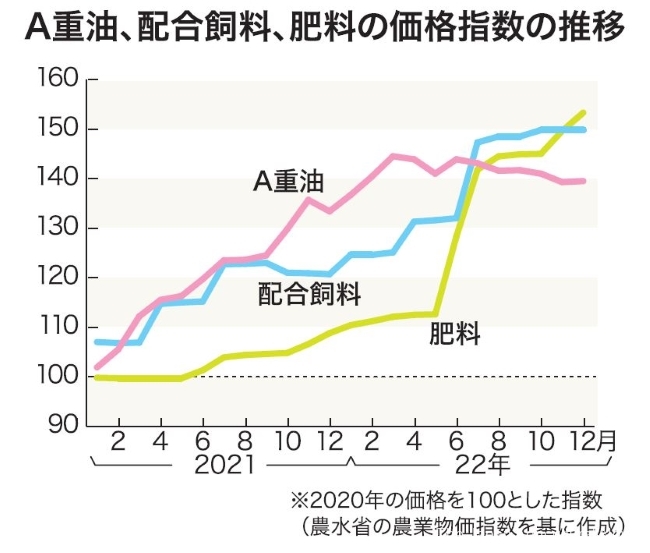Japan’s agricultural exports rise 11% in 2022 excluding processed items
TOKYO, Feb. 4 — The value of Japan’s exports of primary agricultural products in 2022 rose 11 percent from the previous year to 381.8 billion yen.
The figure was calculated by subtracting the value of exports of processed food items from the total amount, based on the data released by the agriculture ministry on Feb. 3.
Amid the recovery of demand for eating out as well as the steady household and gift demands, orders for Japan-made produce increased due to their comparatively low prices thanks to the weak yen.
Japan is facing the challenge of maintaining the popularity of its farm products, as consumption is expected to slow down in the United States and the yen is likely to strengthen from now on.
The total export value of the country’s agricultural items and food products including small packages increased 14 percent to a record high of 1.4148 trillion yen.
Exports of farm products rose 10 percent to 887 billion yen, while overseas shipments of forestry products increased 12 percent to 63.8 billion yen. Exports of fishery commodities were up 29 percent, totaling 387.3 billion yen, helped by increased shipments of seafood such as scallops.
Shipments of primary agricultural products rose 11 percent to 381.8 billion yen, occupying some 30 percent of the total value.
Record high exports were reported for milk and dairy products, eggs, rice, green tea and many fruits and vegetables including apples and strawberries.
Big gainers among milk and dairy products were powdered milk, ice cream and long-life milk.
Shipments of Japan-produced rice increased as a substitute for its rival, U.S.-made rice, whose prices rose, and also helped by Japanese restaurant chains opening more locations.
Household and gift demands for apples and strawberries increased mainly in Hong Kong and Taiwan.
Shipments of beef, one of the major export items, dropped 4 percent to 52 billion yen, posting a decline for the first time in two years, reflecting decreased exports to Cambodia and the U.S.
Shipments to the U.S. were affected by the economic downturn spurred by inflation and higher tariffs imposed on beef shipped to the U.S. because the country’s low-tariff beef import quota had reached its upper limit.
By country, China was the top importer of Japanese products, with Japan’s China-bound exports rising 25 percent to 278.3 billion yen even though the shipments were partly affected by COVID-19 lockdowns in the country.
Shipments to Hong Kong dropped 5 percent to 208.6 billion yen, reflecting restrictions on dining out amid the pandemic.
Yearly exports to the U.S. rose 15 percent in 2022 to 193.9 billion yen, but monthly shipments have declined since October because of the drop in consumption.
Exports to Taiwan, which lifted its import ban on food products linked to the 2011 Fukushima nuclear disaster in February last year, climbed 20 percent to 148.9 billion yen.
The Japanese government is aiming to boost exports of agricultural products to 2 trillion yen in 2025 and 5 trillion yen in 2030.
Challenges remain, with 12 countries and regions still keeping restrictions on imports of Japan’s farm and food products imposed after the nuclear disaster. Japan also needs to work on strengthening protection of intellectual property rights of developers of new agricultural products and nurturing large-lot production areas.
“We can’t say that all of agricultural and livestock products are doing well,” said agriculture minister Tetsuro Nomura at a news conference on Feb. 3.
We hope to promote exports by taking a market-in approach,” Nomura stressed, expressing eagerness to grasp market needs and boost cooperation with local businesses through the agricultural product export support platform that the government is establishing in areas where Japan’s farm products are exported.
Source: http://english.agrinews.co.jp/?p=10396

